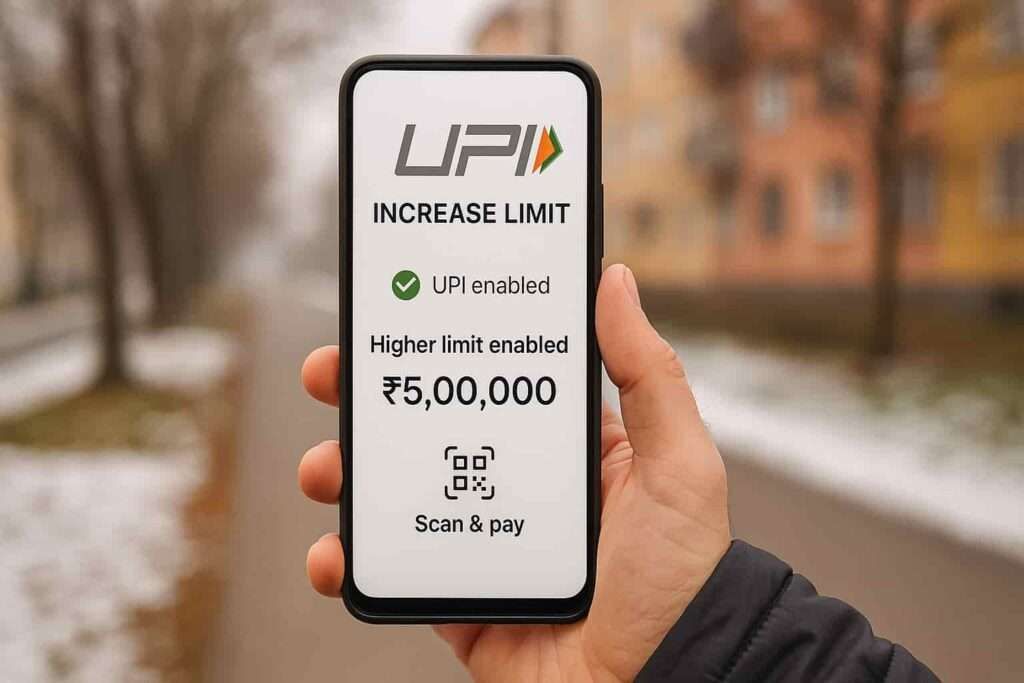Timing 10:10 PM: Unlike earlier, where UPI was mostly capped at ₹1 lakh per day for almost everyone, new NPCI guidelines now allow selected high-value categories to touch ₹5 lakh, ₹6 lakh, and in some cases even ₹10 lakh per day.
But here’s the catch — your bank decides how much you can actually send, not PhonePe, Google Pay, or Paytm.
This is why your friend can send ₹1 lakh, but your payment over ₹25,000 fails. The difference is not the app but it’s the bank’s risk policy.
Let’s break down the new limits, how UPI identifies your payment type, and how to increase your limit instantly.
New UPI Limits: Category-Wise Breakdown
| Payment Type | Old Limit | New Approved Limit | Who Decides the Final Limit? |
|---|---|---|---|
| Regular UPI (P2P) | ₹1 lakh/day | ₹1 lakh/day (unchanged) | Your Bank |
| Hospital / Healthcare | ₹1–2 lakh | Up to ₹5 lakh | Bank + Merchant Category |
| Education Fee | ₹1–2 lakh | Up to ₹5 lakh | Bank |
| Insurance Premium | ₹2 lakh | Up to ₹5 lakh | Bank |
| Capital Market / Investments | ₹2 lakh | Up to ₹5 lakh | Bank |
| Credit Card Bill Payment | ₹1–2 lakh | Up to ₹6 lakh | Bank |
| Government Payments (Tax/GeM) | ₹1 lakh | ₹5–10 lakh | Bank |
Key point: NPCI gives permission, but your bank gives actual power.
How Does UPI Know What Kind of Payment You Are Doing?
UPI identifies your transaction in real time using:
1. Merchant Category Code (MCC)
Every hospital, school, insurance company, or investment platform is registered with a specific MCC.
Example:
- Hospital MCC → Healthcare
- Insurance MCC → Premium Payments
- Broker MCC → Capital Markets
UPI reads the MCC instantly → decides if the txn falls under the high-value category → applies the higher limit.
2. Bank Risk Engine
Each bank runs a real-time check on:
- Your account type
- Your past payment behaviour
- Recent device/SIM change
- Wrong PIN attempts
- Suspicious activity
If everything is safe, → a higher limit is allowed.
If anything looks risky, → the bank reduces your limit automatically for 24–72 hours.
3. NPCI Rule Mapping
UPI also checks such as:
- The merchant is “verified”
- The category is allowed for high-value limits
- The bank supports that high-value category
Only then does the ₹5–6 lakh limit apply.
How to Check & Manage Your UPI Limit (Real Time)
1. Check Your Limit in the Bank’s App
Go to your bank’s mobile app or visit bank’s netbanking portal directly using Chrome – UPI / Fund Transfer / Manage Limits
Here you will see:
- Daily limit
- Per-transaction limit
- Category-based limits (if supported)
This is the source of truth for all UPI apps.
2. Refresh Limit in UPI Apps
PhonePe, Cred, Flipkart Pay, Google Pay, Paytm → UPI Settings → View/Refresh UPI Limit
If the limit recently dropped due to:
- Device/SIM change
- Wrong UPI PIN
- New app installation
Refreshing + entering UPI PIN resets it.
3. Increase Limit (If Bank Allows)
Some banks (ICICI, HDFC, Axis, SBI YONO for premium accounts) allow users to edit:
- Per transaction limit
- Daily limit
If the bank approves ≈ limit updates across all UPI apps in 1–3 minutes.
Why Your UPI Limit Might Still Be Low
Banks may refuse to increase limits because of:
- New UPI registration
- New device
- Suspicious login
- High transaction load (festivals)
- Cooling-off period after PIN reset
- Basic savings account restrictions
In such cases, the user can use IMPS, NEFT if the payment is bigger than 2 Lakh, choose RTGS, online it is free and very fast.
In short, your bank decides your real limit, not PhonePe, GPay, or Paytm. Understanding your bank’s UPI rules is the only way to make large payments without stress, failure, or delays.
UPI Archive – With Bahrain onboard, UPI now connects 9 countries — but how global can it really get?







